This December, after more than 22 years with Mariachi Vargas de Tecalitlán, Julio Martinez will bid his final farewell to “The World’s Greatest Mariachi.” As part of the Mariachi Vargas concert on Friday, December 2, 2017, at San Antonio’s Lila Cockrell Theatre, the Mariachi Vargas Extravaganza will acknowledge Julio for his vast contributions to Mariachi Vargas and to the art of the mariachi harp. In the following interview, Julio talks about his tenure in Mariachi Vargas, the role of the harp in mariachi music, and his plans for the future.
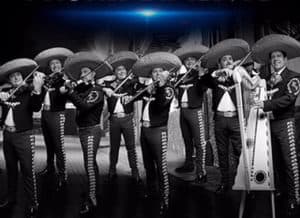
Julio with Mariachi Vargas de Tecalitlán
Jonathan Clark (JC): From your perspective, Julio, what has the traditional role of the harp been in Mariachi Vargas?
Julio Martínez (JM): Well, when I entered Vargas in August of 1995, the harp was considered a supplemental instrument used to reinforce the bass, play chords, and fill occasional introductions or adornos that weren’t covered by the trumpets or violins. It wasn’t an essential instrument, unlike when the group was formed in 1898. Back then, it was a foundational part of the ensemble, carrying both melody and bass line, accompanied by a guitarra de golpe and two violins. So in the beginning, the harp was indispensable in Mariachi Vargas. But over time, as more instruments were added, it gradually became relegated to the role of an extra or optional instrument.
JC: In the 22 years you’ve been with Mariachi Vargas, how has the role of the harp in that group changed?
JM: One of my greatest satisfactions is that, due to my efforts, large or small, the harp now plays a more important role in Mariachi Vargas. Before I entered the group, the public payed attention to the voices and the other instruments, but the harp barely shined and rarely caught their attention. By contrast, after I joined Vargas, people began turning their eyes toward the harp.
JC: You told me that when you started playing with Mariachi Vargas, it was somewhat rare for a mariachi to have a harp, and even rarer for mariachi fans to pay attention to that instrument.
JM: Exactly. You know that my first mariachi was Sol de México. When I joined them in 1989, the only famous mariachis that had a harp were Los Camperos, América, and Vargas. It wasn’t until after I entered Vargas in ’95 that other groups began to integrate the harp more frequently. Why? Because they became aware that the instrument was capable of carrying more melody than a simple introduction or an adorno in La Bamba or the Huapango de Moncayo. They realized that it could do many more things. So it gives me great pleasure to see that today, 22 years later, a high percentage of mariachi groups around the world now feature the harp.
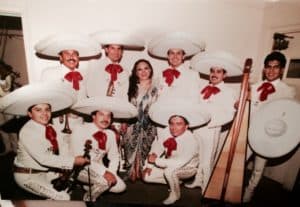
With Mariachi Sol de México and Amalia Mendoza, circa 1989
JC: You say that after you entered Mariachi Vargas, many people started to notice the harp for the first time. But back then, only a few of the group’s numbers contained a harp solo that allowed you to stand out. Isn’t this true?
JM: Yes. For example, Violín Huapango had already been recorded by my predecessor, Arturo Mendoza, and his solo served as a starting point for me. But I extended it, adding more ornaments to make it more spectacular, and that caught people’s attention. My idea has always been to make the harp more spectacular. For example, when don Pepe Martínez said to me: “Let’s work out an arrangement for Carmentea” (a Colombian song), I tried to make it more sensational. The same thing happened with El Cascabel, the same with La Bamba. They’re musically simple, but within that simplicity, I tried to make them spectacular. And that was what caught people’s attention.
JC: May I ask you why you’re leaving Mariachi Vargas?
JM: In my two decades with the group, I think I’ve done what I needed to do in Mariachi Vargas. I feel I’ve accomplished a lot and done many valuable things, but I still want to do more, and I think it’s time for me to go on to projects that I’ve always wanted to do, but couldn’t as a member of Vargas.
JC: What do you think are your most important contributions during your tenure with Mariachi Vargas?
JM: I think I left a legacy in the songs where they allowed me to shine. The most spectacular are El Cascabel, Carmentea, and La Bamba. Those recordings and videos form a permanent record, so people will be able to evaluate them in the future. The group recently mounted El Siquisirí, a son veracruzano where my solo gets a lot of applause, but I don’t know if it’ll be recorded commercially.
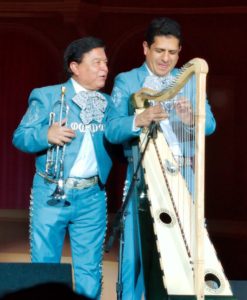
With Federico Torres
JC: For you, what are the most memorable moments since you’ve been with Mariachi Vargas?
JM: To have performed with the Jalisco Philharmonic, with the New York Symphony, the Houston Symphony, and the Prague Symphony, in the Czech Republic. Also with the Youth Symphony of Madrid, in Spain. But the most memorable moment took place at the Rodolfinum Theater, in the city of Prague. The last number of the concert was Violín Huapango. The audience applauded my solo performance enthusiastically, but when the piece ended, the orchestra’s director stepped down from the podium and walked straight toward me. He shook my hand, gave me a hug, and personally congratulated me. The whole audience was on its feet in a standing ovation!
JC: Was that the most unforgettable moment of all for you?
JM: Well, every tour had its magical moments. In Japan, in 1997 and ’98, we also had some very memorable concerts. And I failed to mention the opera Cruzar la Cara de la Luna (Crossing the Face of the Moon), which was one of my biggest satisfactions. We presented it with great success in San Diego, Chicago, Houston, Phoenix and other cities, but what made the largest impact on me was when we filled the Théâtre du Châtelet in Paris for seven days straight.
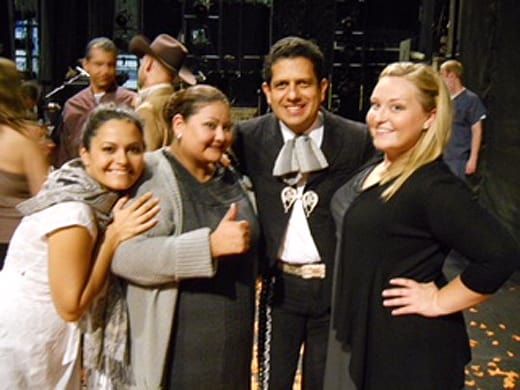
With Vanessa Alonzo and cast members of Cruzar la Cara de la Luna
JC: When you leave Mariachi Vargas, what are you going to miss the most?
JM: First and foremost, the group’s sound. I’ve played with many mariachis, in many places, and for me none compare with Mariachi Vargas in sound. I’ll miss the group’s style and its manner of interpretation.
JC: What are the lessons you’ve learned as a member of Mariachi Vargas that will serve you in the future?
JM: The musical discipline, the professionalism, and the dedication and seriousness while performing on stage.
JC: What do you foresee for the future of mariachi music?
JM: Well, a very regrettable phenomenon is occurring in Mexico: You find less and less interest in mariachi music, and the younger generations don’t pay much attention to it, which is why it’s declining in popularity. Nonetheless, mariachi music continues to grow outside of Mexico, particularly in the United States. It’s also growing immensely in Colombia where there are extraordinary musicians who play our music well, as there are in other South American countries. For this reason, I believe the future of mariachi music will take place outside of Mexico.
JC: What are your personal plans for the future?
JM: I’m now 56 years old, and as long as I retain my faculties as a performer, I want to do things with the harp that I wasn’t able to as a member of Mariachi Vargas. I also want to continue imparting my knowledge. I’ve been invited to give workshops both in California and Texas, and in other parts of the United States. And I want to continue playing in duet with my brother, Javier Martínez.
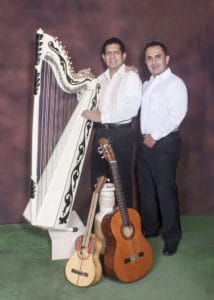
Julio and Javier Martínez
I’d also like to give concerts as a soloist with symphony orchestras and with other types of musical ensembles. I was fortunate enough to perform the Paraguayan piece El Tren Lechero for harp, mariachi, and orchestra, and I’d like to do more collaborations like that. I also have an original arrangement for harp and orchestra of the Venezuelan joropo Concierto el la Llanura that I’ve never yet had the opportunity to present.
JC: Do you plan to make recordings?
JM: Well, I already have six harp discs, and I plan to make more, but at the moment I have no recording plans. Starting in 2018, I’ll be free and will start to plan what I’m going to do next. I also want to produce mariachi music concerts where my brother Javier can sing, and where I can invite other singers like Steeven Sandoval, Azucena de la Torre, Manuel and Angélica Vargas, Arturo Vargas, Adela Reyes, Claudia Sierra, Juan Carlos and Rocío Salazar, Alejandra Orozco, Mayela Orozco, Mario Valencia, Jazmín de la Rocha… consummate artists who have little support from the communications media.
JC: How would you like to be remembered?
JM: I’ like to be remembered as a versatile harpist who did memorable things inside and outside of Mariachi Vargas, and who expanded the harp’s role within that group. Also, as a musician who’s partially responsible for increasing the number of mariachi groups that include the harp today.
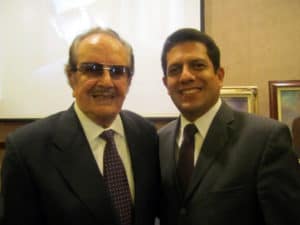
With maestro Rubén Fuentes
JC: In reference to the Mariachi Vargas Extravaganza, you must have impacted the musical life of hundreds of young participants over the last two decades. What can you tell us about your participation in this important annual event?
JM: Well, it’s been growing over time. When I first started giving workshops there with Vargas in 1995, I only taught a harpist or two. But lately, I’ve had 20 or 25 harp students in those same workshops, an increase I consider significant. The popularity of the harp has increased greatly in the state of Texas and beyond.
Being part of the teaching staff of the Mariachi Vargas Extravaganza has given me great satisfaction. Everyone knows me there, and thanks to that festival, I’ve become known not only in Texas but throughout the United States. There are students who started with me in elementary school and are now professional musicians, playing in fine groups. I have at least ten outstanding students who started with me in the Extravaganza.
JC: Do you know who your successor in Mariachi Vargas will be?
JM: I give you my word that I don’t! But I’m not worried about it, because I think I’ve left a legacy in Mariachi Vargas, and the person who takes my place has to continue it and do his respective duty — and work hard to take the instrument to the next level!
JC: Well, Julio, I wish you the best of luck in this new phase of your career!
JM: Thank you, Jonny, for interviewing me.
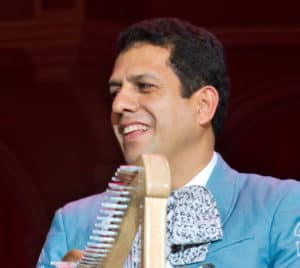
Testimonies from some of Julio’s students
My interest in the mariachi harp started when I first saw the 2003 PBS program Mariachi, the Spirit of Mexico. In that documentary, Julio plays La Bamba with Mariachi Vargas as part of the popurrí Veracruz III. I asked my dad, “What instrument is he playing? It sounds so amazing!” “Es el arpa,” he replied. I didn’t even know what a harp was. Shortly after that, I joined La Joya High School’s mariachi class. Andrés Aguilar, from Veracruz, was an assistant teacher there, and he taught me to play the harp.
About three years later, as a college student, I joined UT Pan-Am’s Mariachi Aztlán. One of the first conferences I attended with them was the Mariachi Vargas Extravaganza, and that’s where I met Julio Martínez in 2009. Since the time I began studying the harp, I’d been constantly searching for him on YouTube and playing along with his videos, pretending I was him!
In 2013, when Aztlán was called to substitute for Mariachi Vargas in the opera Cruzar la Cara de la Luna, I found myself having to cover for this artist I’ve always admired and imitated. In that opera, I found myself channeling Julio’s spirit, trying my best to play like him. It was a surreal experience!
I think Julio Martínez really opened the door for the modern mariachi harp. He is the archetypeal mariachi harpist, and the harp world owes him a deep debt of gratitude.
—Charlie López, Sharyland High School mariachi director

Charlie and Julio in 2013
“Of all the harp workshops I’ve attended, Julio’s are my favorite. He’s charismatic, he’s an amazing harpist, and he’s articulate at explaining things. If you don’t understand something right away, he’ll demonstrate and explain it in different ways until you get the point. He’s very creative, and if I ask him how to play a certain song, he’ll show me two or three different ways to play it, then encourage me to come up with my own variations. This motivates me to become like him some day.”
—Jacob Cruz, Roma High School freshman
“I first heard Julio Martínez with Mariachi Vargas in 1999, when I was a sophomore in high school, and he inspired me to want to play the harp. Julio was my main role model on the instrument, and because of him, in great part, I’m the mariachi educator I am today.”
—Abiel Hinojosa, Roma Middle School mariachi director
How can I put into words how amazing Julio Martínez is, and the influence he has had on me, not only as a musician and educator, but as a person? He has been my teacher, mentor, and padrino. He has taught me how to pursue goals and endure hardships with the poise of humility.
Back in my high school days, there were no local harpists in San Antonio; there was no internet, much less videos. But there was the Mariachi Vargas Extravaganza. In the fall of 1996, I attended, bright-eyed and disoriented. Another girl and I were taking Julio’s class together. She played a short harp solo for him, and my heart sank because I couldn’t do the same. I got nervous, but he smiled and told me not to worry — that’s what he was there for.
The rest of the day was spent explaining basics, chord structures, implementation of glissandos based on melody lines, bass line, hand techniques, solfege from note letter names… In short, he was my first music theory teacher. He had opened up an entire new world to me and helped me gain confidence. From that moment, I knew I would pursue a career in music education.
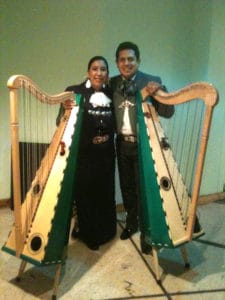
Gabriela and Julio in 2012
Julio has been such an important part of my life. Throughout my struggles and frustrations, he has always been there to advise me and keep me motivated. Just when I thought it was time to give up, he would help me to see the positive in each situation and see my own self-worth. My teaching career and music philosophy are forever indebted to him.
I strongly believe that knowledge, connections, and accomplishments are of little avail by themselves. If you don’t pass on your knowledge to the next generation with grace and humility, you have misused a beautiful gift. To have a performer of this caliber selflessly impart their expertise for the perpetuation of the genre is incomparable.
Paradoxically, Julio calls me “Maestra.” I know he addresses me with that title to keep me motivated so that I will share my knowledge with my students, who in turn will share it with others. And together we will do our part to keep this beautiful music alive.
When you see the end of a road approaching, you often think of the beginning. I know Julio will go off and do many wonderful things. It has truly been an incredible journey.
—Gabriela Fuentes, Director of Mariachi Education
Metropolitan Nashville Public Schools

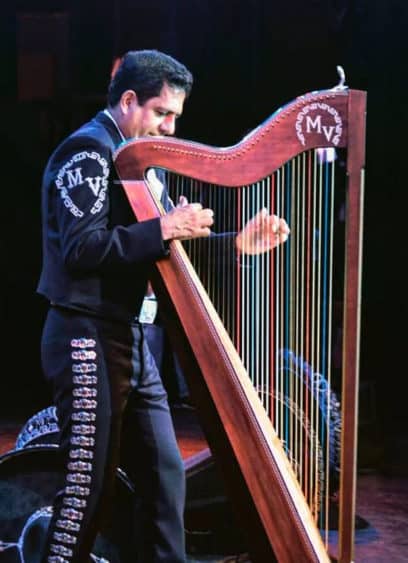



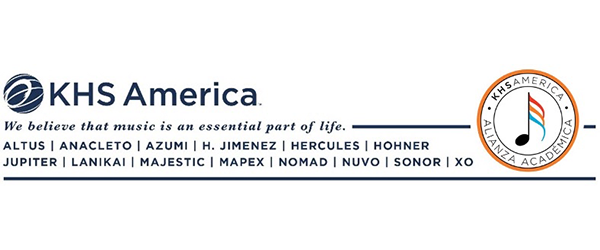

Hey, Julio!!! Soy Brigitte de Alemania, una vieja amiga de tu hermano Javier. No sé si te acuerdas de mí- yo fui a visitarles en 1998 y conocí a toda su familia!
¡Muchas gracias y un saludo cordial desde Alemania!